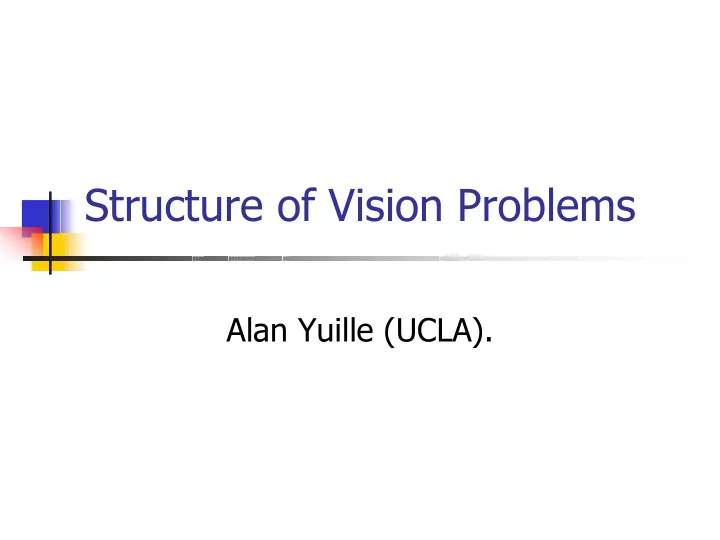

Structure of Vision Problems Alan Yuille (UCLA).
Machine Learning � Theory of Machine Learning is beautiful and deep. � But, how useful is it for vision? � Vision rarely has an obvious vector space structure.
Image Formation � Images formation is complicated. � E.g. the image of a face depends on viewpoint, lighting, facial expression.
Image Formation. � Parable of the Theatre, the Carpenter, the Painter, and the Lightman. (Adelson and Pentland). � How many ways can you construct a scene so that the image looks the same when seen from the Royal Box?
Nonlinear Transformations � Mumford suggested that images involve basic nonlinear transformations. � (I) Image warping: x W(x) (e.g. → change of viewpoint, expression, etc.). � (II) Occlusion: foreground objects occlude background objects. � (III) Shadows, Multi-Reflectance.
Complexity of Images � Easy, Medium, and Hard Images.
Discrimination or Probabilities � Statistical Edge Detection (Konishi,Yuille, Coughlan, Zhu). � Use segmented image database to learn probability distributions of P(f|on) and P(f|off), where “f” is filter response.
P-on and P-off � Let f(I(x)) = |grad I(x)| � Calculate empirical histograms P(f=y|ON) and P(f=y|OFF). � P(f=y|ON)/P(f=yOFF) is monotonic in y. � So loglikelihood test is threshold on |grad (I(x)|.
P-on and P-off � P-on and P-off become more powerful when combining multiple edge cues (by joint distributions). � Results as good, or better than, standard edge detectors when evaluated on images with groundtruth.
P-on and P-off � Why not do discrimination and avoid learning the distributions? (Malik et al). � Learning the distributions and using log- likelihood is optimal provided there is sufficient data. � But “Don’t solve a harder problem than you have to”.
Probabilities or Discrimination � Two Reasons for Probabilities: � (I) They can be used for other problems such as detecting contours by combining local edge cues. � (II) They can be used to synthesize edges as a “reality check”.
Combining Local Edge Cues � Detect contours by edge cues with shape priors P_g (Geman & Jedynak). 1 P ( y ) ∑ N = r ({ t }, { y }) log on i i i = N P ( y ) i 1 off i P ( t ) 1 ∑ N g i + log , = N i 1 U ( t ) i U (.) is uniform distributi on .
Manhattan World � Coughlan and Yuille use P-on, P-off to estimate scene orientation wrt viewer.
Synthesis as Reality Check � Synthesis of Images using P-on, P-off distributions (Coughlan & Yuille).
Machine Learning Success � Fixed geometry, lighting, viewpoint. � AdaBoost Learning: Viola and Jones.
Machine Vision Success � Other examples: � Classification (Le Cun et al, Scholkopf et al, Caputo et al). � Demonstrate the power of statistics – rather than the power of machine learning?
Bayesian Pattern Theory. � This approach seeks to model the different types of image patterns. � Vision as statistical inference – inverse computer graphics. � Analysis by Synthesis (Bayes). � Computationally expensive?
Example: Image Segmentation � Standard computer vision task. � Pattern Theory formulation (Zhu,Tu): Decompose images into their underlying patterns. � Requires a set of probability models which can describe image patterns. Learnt from data.
Image Pattern Models � Images (top) and Synthesized (bottom).
Image Parsing: Zhu & Tu
Image Parsing: Zhu & Tu. � Bayesian Formulation: model image as being composed of multiple regions. � Boundaries of regions obey (probabilistic) constraints (e.g. smoothness) � Intensity properties within regions are described by a set of models with unknown parameters (to be estimated).
Image Parsing Results: Input, Segmentation, and Synthesis.
Regions, Curves, Occlusions.
Removing Foreground. � “Denoising” images by removing foreground clutter.
Image Parsing Solution Space � No. regions, Types of regions, Properties of regions.
Machine Learning & Bayes. � Zhu-Tu’s algorithm is called DDMCMC Data-Driven Markov Chain Monte Carlo. � Discrimination methods (e.g. AdaBoost) can be used as proposal probabilities , which can be verified by Bayesian pattern models.
Machine Learning & Bayes � Machine Learning seems to concentrate on discrimination problems. � A whole range of other vision problems – image segmentation, image matching, viewpoint estimation, etc. � Probability models for image patterns are learnable. These models give reality checks by synthesis.
Machine Learning & Bayes � Machine Learning’s big advantage over Bayes is speed (when applicable). � AdaBoost may be particularly useful for combining local cues. � Machine Learning for computational search to enable Bayesian estimation?
Recommend
More recommend